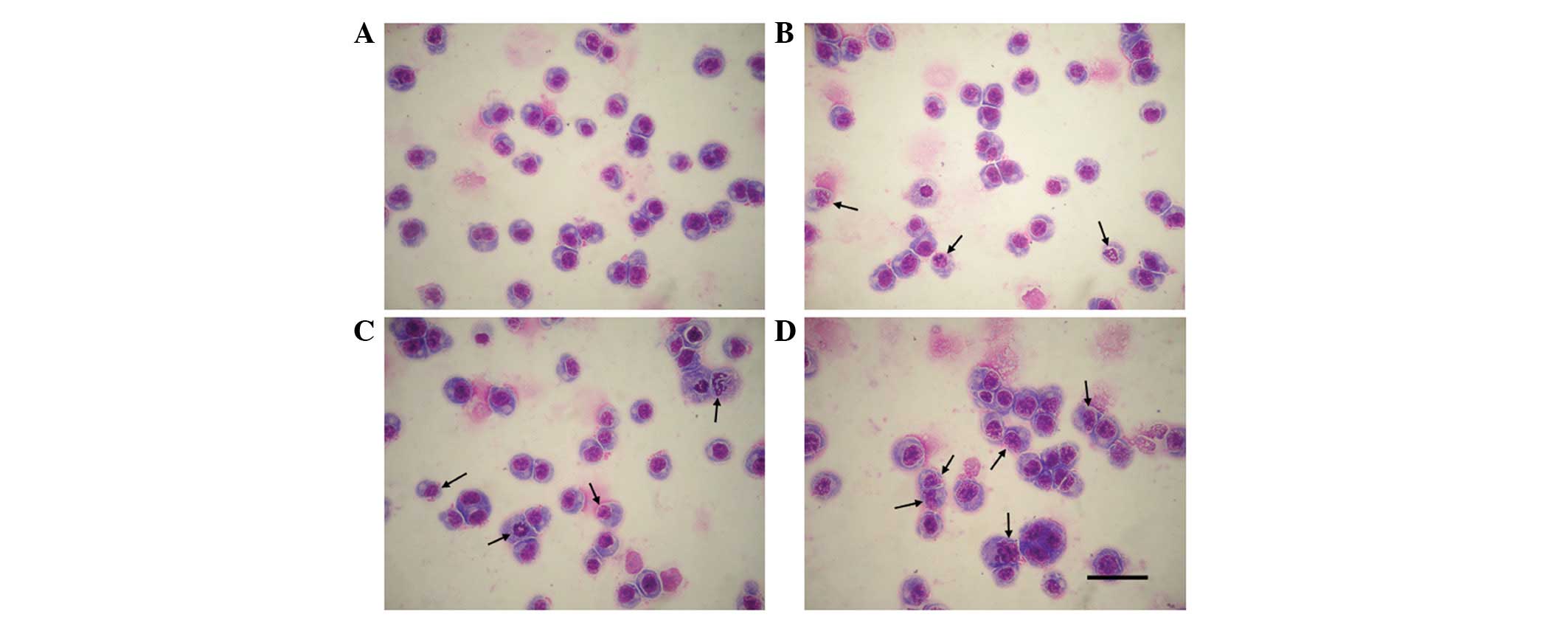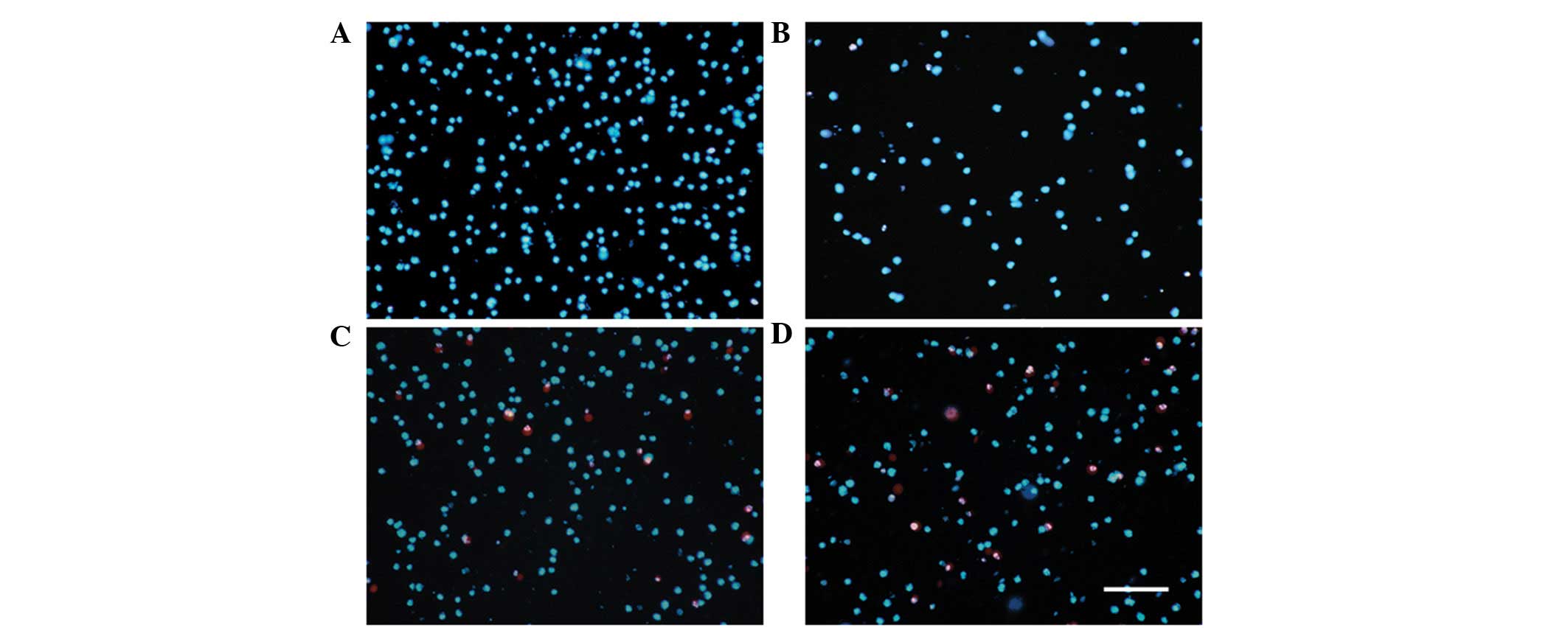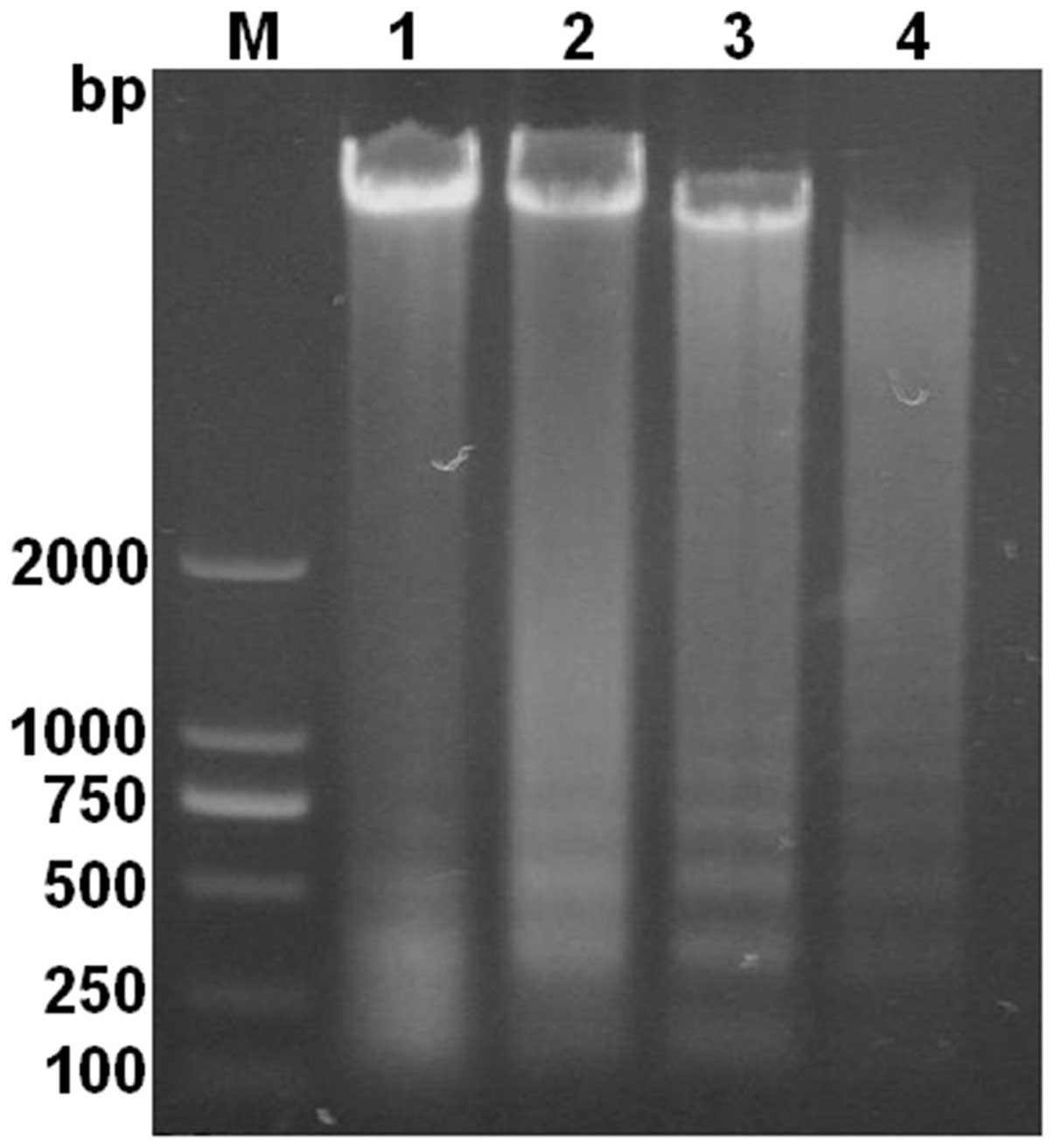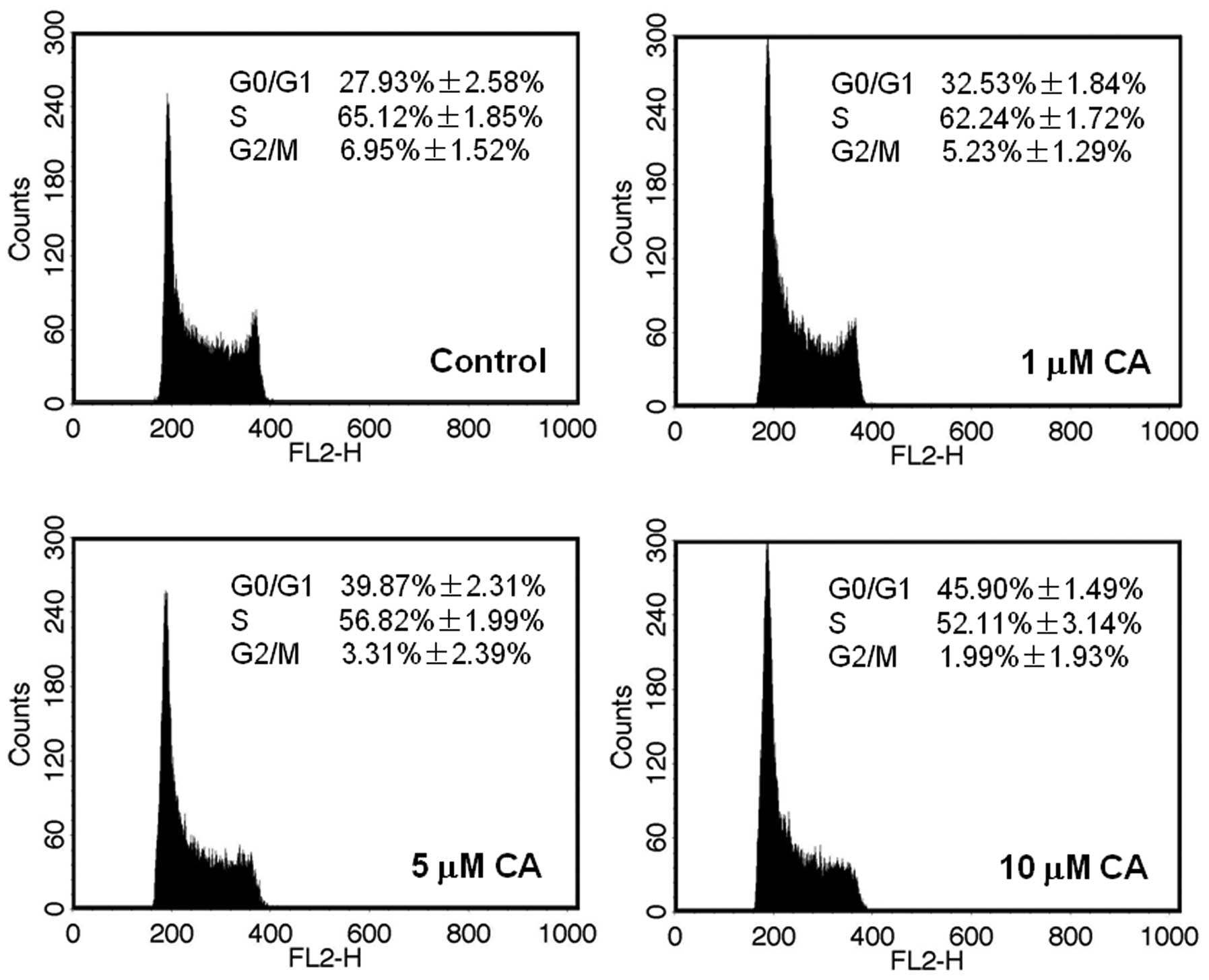Chlorogenic acid induced apoptosis and inhibition of proliferation in human acute promyelocytic leukemia HL‑60 cells
- Authors:
- Published online on: August 27, 2013 https://doi.org/10.3892/mmr.2013.1652
- Pages: 1106-1110
Abstract
Introduction
Leukemia is a heterogeneous group of hematopoietic malignancies that include a number of diverse and biologically distinct subgroups, of which chronic myelogenous leukemia (CML) and acute promyelocytic leukemia (APL) are two types. The former rarely affects children, while the latter affects adults and children. Thus, the treatment and prevention of leukemia is of great importance. Leukemic cells are often a type of overgrown immature cell. Thus, leukemia may be treated by the inhibition of cell growth proliferation, induction apoptosis and terminal differentiation. As medical science progresses, there is an increasing amount of research being performed on the antitumor function in natural medicine.
As an antioxidant, chlorogenic acid (CA) is a type of ester that is widely studied in edible and medicinal plants. It is isolated from Eucommiaceae plants and honeysuckle and has marked antioxidant and anti-inflammatory effects. In addition, it may prevent diabetes and cardiovascular disease (1–3). Recent studies have demonstrated that CA has the activity of induced human hepatoma and glioma cell apoptosis (4,5). CA reportedly possesses antitumor activity via the induction of apoptosis in human CML cell lines, including U937 and K562 cells (6,7). However, the effects of CA on human APL HL-60 cells remain unknown.
The current study aimed to investigate whether CA inhibits proliferation and induces apoptosis in human leukemia HL-60 cells. The results suggest that CA may be available for the clinical treatment of human acute promyelocytic leukemia.
Materials and methods
Chemical reagents and cells
HL-60 cells were obtained from the China Center for Type Culture Collection (Wuhan, China). CA was purchased from Sigma-Aldrich (St. Louis, MO, USA) and was dissolved at a concentration of 0.1 M in DMSO as a stock solution stored at −70°C. Fetal bovine serum (FBS) was purchased from Gibco-BRL (Grand Island, NY, USA). Hoechst and PI staining, DNA Ladder Extraction, Trypan Blue Staining Cell Viability assay kits, propidium iodide (PI) and RNase were purchased from Beyotime Institute of Biotechnology (Shanghai, China). Giemsa stain was purchased from the Beijing Dingguo Changsheng Biotechnology Co., Ltd. (Beijing, China).
Cell culture
HL-60 cells were maintained in RPMI-1640 (Gibco-BRL) medium supplemented with 10% heat-inactivated FBS, at 37°C in a 5% CO2 humidified incubator. Cells were harvested by centrifugation at 38 × g for 5 min and resuspended in fresh medium every two days.
Cell viability analysis
Cells in logarithmic phase growth were seeded at a concentration of 1×105 cells/ml in a 24-well plate (Corning Incorporated, New York, NY, USA) and treated with 0, 1, 5 and 10 μM CA, respectively. Following 24, 48, 72, 96 and 120 h, the cells were harvested, diluted by trypan blue working solution and counted with an automated cell counter (Bio-Rad Laboratories, Inc., Hercules, CA, USA) to allow for growth curve construction.
Wright-Giemsa staining
Cells treated with CA at the indicated concentrations for 48 h were harvested and collected on slides, air-dried, stained with Wright for 5 min at room temperature and one drop of Giemsa was added. The staining solution was diluted with PBS to form a water break-free surface. After 15 min, the slides were rinsed in deionized water and air-dried. The cells were observed by light microscopy (Olympus Corporation, Tokyo, Japan) and images were captured by digital camera (Olympus) (8).
Evaluation of apoptosis by nuclear morphology
Cells in logarithmic phase growth were seeded at a concentration of 1×105 cells/ml in a 24-well plate and treated with CA (1, 5 and 10 μM, respectively). After 48 h, the cells were incubated for 15 min at 37°C with the DNA-specific dye Hoechst 33342 and propidium iodide (PI). Nuclear morphology was investigated by fluorescence microscopy (Olympus) and images were captured using a digital camera (Olympus).
DNA ladder analyze apoptosis
Cells treated with CA at the indicated concentrations for 48 h were harvested and washed with PBS (pH 7.4). DNA was then extracted from the cells according to the DNA Ladder Extraction kit instructions. Samples were separated by electrophoresis on 1.5% (w/v) agarose gels containing GoldView and subsequently the separated DNA ladders were visualized using a UV transilluminator (Beijing Liuyi Instrument Factory, Beijing, China). The size of the DNA ladders was determined by comparison with DL2000 DNA markers (Takara Biotechnology Inc., Dalian, China).
Cell cycle analysis
Cells treated with CA for 48 h were harvested and washed twice with ice-cold PBS. The cells were fixed for 30 min at 4°C in ice-cold 70% ethanol. The cells were washed twice with PBS and resuspended in 50 μg/ml DNase-free RNase (Sigma-Aldrich) at 37°C for 30 min. PI (25 μg/ml; Sigma -Aldrich) was added at 4°C for 30 min in the dark. The cells were then analyzed using a flow cytometer (FACSCalibur, Becton-Dickinson, San Jose, CA, USA) and histograms were analyzed by ModFit software (Becton-Dickinson).
Statistical analysis
Data obtained from experiments are presented as means ± SEM from at least three independent experiments. Statistical analyses were performed by one-way analysis of variance followed by the Student’s t-test. P<0.05 and P<0.01 were considered to indicate a statistically significant difference.
Results
Cell viability analysis
Cell proliferation is a crucial marker for the promotion and progression of carcinogenesis. As a result, to investigate cell viability and the effect of CA on the proliferation of HL-60 cells, cells treated with specific doses of CA were examined using a growth curve constructed using trypan blue staining. Cell viability in the control increased in a time-dependent manner, reached a plateau at 72 h and persisted until at least 120 h. This same change was observed in CA-treated groups. However, when compared with the control, cell viability in CA-treated groups decreased significantly at 72 h and cell viability decreased with an increasing dose of CA. The results indicated that growth of HL-60 cells reached a plateau at 72 h and when treated with CA, cell growth was inhibited significantly in a dose- and time-dependent manner compared with the control (Fig. 1). According to the growth curve, the optimal HL-60 cell growth was identified at 48 h. In the subsequent experiments, induction of apoptosis and inhibition of cell proliferation were estimated, respectively, following 48-h cell treatment with various doses of CA.
Effects of CA on the morphological changes of HL-60 cells
As morphological changes of cells are key for the detection of cell apoptosis, the morphological changes of HL-60 cells following 48 h of CA treatment were observed using Wright’s-Giemsa staining. Following treatment for 48 h, the irregular changes in morphology, including shrinkage of the cell membrane were detected in the 1 μM CA group. As the concentration of CA increased, apoptotic cells significantly increased and generated more apoptotic bodies when compared with the control (Fig. 2).
Apoptosis and necrosis assay
To detect the apoptosis and necrosis of HL-60 cells following 48 h treatment with CA, the cells were stained with Hoechst and PI. The results indicated that, in the CA-treated groups, early apoptotic nuclei had an appearance of bright blue fluorescence accompanied with cell nuclear morphological changes and the late apoptotic cell membrane was damaged, which was dyed red by PI, whereas the normal cells showed a faint blue. Following 48-h treatment with CA, the results revealed that together with the concentration of CA increasing, the number of late apoptotic cells increased in a dose-dependent manner (Fig. 3).
DNA ladder analysis apoptosis
Since the DNA ladder is a significant marker for the study of apoptosis, to analyze the apoptosis of HL-60 cells at the molecular level, agarose gel electrophoresis of DNA samples from the cells treated with CA for 48 h was performed. A characteristic DNA ladder was observed along with an increasing concentration of CA (Fig. 4). The results also showed that, following 48 h of CA treatment, apoptotic cells increased in a dose-dependent manner.
Cell cycle arrest by CA
Cell cycle arrest is a regulatory process that halts progression through the cell cycle during normal phases (G1, S, G2 and M). To investigate whether the growth inhibitory effect of CA resulted from growth arrest, the present study analyzed the cell cycle following 48 h of treatment with 0, 1, 5 and 10 μM of CA. The results indicated that the G0/G1 phase of HL-60 cells treated with CA, increased significantly in concordance with a decrease of the S and G2/M phases and CA induced an increased G0/G1 phase arrest in a concentration-dependent manner (Fig. 5). When cells were treated with 1 μM of CA a slight accumulation (~32.53%) of cells in G0/G1 phase was observed. However, when 5 μM of CA was added to cells, a significant accumulation (~39.87%) of cells in G0/G1 phase was observed. Cells treated with 10 μM of CA resulted in a more significant (~45.90%) enhancement of cells in G0/G1 phase.
Discussion
It is well established that cancer cells evade apoptosis by the accumulation of a number of genetic and epigenetic changes (9). Thus, leukemia may be treated by the inhibition of APL cell growth proliferation and induction of apoptosis. An increasing number of studies have focused on natural drugs to treat leukemia. A number of previous studies have shown that Artemisinin (10), Isoliquiritigenin (11), Pycnogenol (12) and other natural drugs have been shown to effectively inhibit APL cell growth proliferation, induce apoptosis and differentiation. Thus, it is crucial to identify safer drugs that yield the same or improved effects, but with fewer side effects.
A previous study revealed that a number of natural drugs from plants were found to inhibit APL cell growth proliferation and induce apoptosis in human APL cells. CA is a type of phenolic antioxidant, with low toxicity and less side effects, with a marked antioxidant and antibacterial effect. CA may prevent colon (13) and liver cancer (14). It reportedly possesses antitumor activity via the induction apoptosis of CML cell lines, including U937 and K562 cells. However, no study is currently available on the use of CA treatment on APL HL-60 cells. Thus, the current study investigated the ability of CA to inhibit HL-60 cell growth proliferation and to induce apoptosis.
To clarify the effects of CA on growth proliferation and apoptosis in human APL HL-60 cells, the present study first investigated cell viability and the effect of CA on the proliferation of HL-60 cells using a growth curve constructed using trypan blue staining. According to the growth curve, the growth of HL-60 cells reached a plateau at 72 h. When treated with CA, the cell growth was inhibited significantly in a dose- and time-dependent manner and the optimal time of HL-60 cell growth was identified at 48 h (Fig. 1). Thus, in the subsequent experiments, the inhibition of proliferation and induction of apoptosis were estimated following 48 h treatment with various doses of CA. Cell apoptosis in cell development, growth, maturation and differentiation is important in the process of carcinogenesis and is significant in the research and treatment of tumor development. In the current study, Wright-Giemsa staining was implemented to observe the morphological changes of HL-60 cells following 48 h CA treatment. The cells treated with CA revealed the characteristics of apoptosis (Fig. 2). Thus, this result suggests that CA may induce apoptosis in HL-60 cells. The distinct morphological features of apoptosis in HL-60 cells treated with CA were observed in a concentration-dependent manner, when cells were observed by fluorescence microscopy following staining with Hoechst and PI (Fig. 3). A significant characteristic DNA ladder was observed with an increased CA concentration, which further suggests that CA has specific leukemia cell apoptosis-inducing activity in HL-60 cells at the molecular level (Fig. 4).
Cancer cells evade programmed cell death, thus increasing their life span, which is different from normal cells (9). A number of previous studies have shown that numerous anticancer drugs achieve cell cycle regulation through specific blockage of the cell cycle in the two-phase transformation point of G0/G1 to S and G2 to M (15–17). In the present study, the cell cycle was analyzed using flow cytometry and the results showed that CA may induce HL-60 cell G0/G1 phase arrest with a decrease of S and G2/M phase. The current study has found that CA may induce HL-60 cell G0/G1 phase arrest and the result suggests that CA also has specific HL-60 cell growth inhibition-inducing activity.
The Bcl-2 gene family is significant in the regulation of cell apoptosis. It has been demonstrated that flavonoid compounds, including baicalin may induce apoptosis in HL-60 cell lines by downregulating the expression of Bcl-2 (18). Besides the Bcl-2 gene family, the caspase family is also crucial in apoptosis. As the most important member of the caspase family, caspase-3 has been widely studied. Under a variety of apoptotic stimuli, procaspase-3 is hydrolyzed to active caspase-3 and cleaved with PARP (poly(ADP-ribose) polymer-rase). As a result, the activity of the PARP-negatively regulated Ca2+/Mg2+-dependent endonuclease increased to cleave the DNA between nucleosomes and induce apoptosis (19). Phosphatidylinositol-3-kinase (PI3K) is an important intracellular signaling pathway associated with apoptosis and Akt is a potent kinase for Bad, which is an apoptotic member of the Bcl-2 family which may displace Bax from binding to Bcl-2 and Bcl-XL, resulting in cell death (20). Thus, it is hypothesized that CA may induce cell apoptotis by downregulating Akt expression in Hl-60 cells. CA is also hypothesized to inhibit proliferation and promote the apoptosis of the HL-60 cells with a possible mechanism involving the downregulation of the expression of Akt, which further downregulates apoptosis-associated proteins, including Bcl-2 and caspase-3. Therefore, a detailed mechanisms of the inhibition of proliferation and promotion of apoptosis in HL-60 cells treated with CA should be further examined.
In conclusion, to the best of our knowledge, the current study provided evidence, for the first time, that CA may inhibit growth proliferation and induce apoptosis in human acute promyelocytic leukemia HL-60 cells. The molecular mechanism of this process requires further investigation in future studies. The results of this study provides a new theoretical basis and therapeutic strategy for CA in the clinical treatment of acute promyelocytic leukemia.
Acknowledgements
This study was supported by a grant from the Top Innovative Talents Training Fund for College Students from Chongqing University of Technology (no. BC201205).
References
|
Gallus S, Tavani A, Negri E and La Vecchia C: Does coffee protect against liver cirrhosis? Ann Epidemiol. 12:202–205. 2002. View Article : Google Scholar : PubMed/NCBI | |
|
Namba T and Matsuse T: A historical study of coffee in Japanese and Asian countries: focusing the medicinal uses in Asian traditional medicines. Yakushigaku Zasshi. 37:65–75. 2002.(In Japanese). | |
|
Phan TT, Sun L, Bay BH, Chan SY and Lee ST: Dietary compounds inhibit proliferation and contraction of keloid and hypertrophic scar-derived fibroblasts in vitro: therapeutic implication for excessive scarring. J Trauma. 54:1212–1224. 2003. View Article : Google Scholar | |
|
Belkaid A, Currie JC, Desgagnés J and Annabi B: The chemopreventive properties of chlorogenic acid reveal a potential new role for the microsomal glucose-6-phosphate translocase in brain tumor progression. Cancer Cell Int. 6:72006. View Article : Google Scholar : PubMed/NCBI | |
|
Granado-Serrano AB, Martin MA, Izquierdo-Pulido M, et al: Molecular mechanisms of (−)-epicatechin and chlorogenic acid on the regulation of the apoptotic and survival/proliferation pathways in a human hepatoma cell line. J Agr Food chem. 55:2020–2027. 2007. | |
|
Bandyopadhyay G, Biswas T, Roy KC, et al: Chlorogenic acid inhibits Bcr-Abl tyrosine kinase and triggers p38 mitogen-activated protein kinase-dependent apoptosis in chronic myelogenous leukemic cells. Blood. 104:2514–2522. 2004. View Article : Google Scholar | |
|
Yang JS, Liu CW, Ma YS, et al: Chlorogenic acid induces apoptotic cell death in U937 leukemia cells through caspase- and mitochondria-dependent pathways. In Vivo. 26:971–978. 2012.PubMed/NCBI | |
|
Zhang XM, Gao N, Chen RX, Xu HZ and He QY: Characteristics of boningmycin induced cellular senescence of human tumor cells. Yao Xue Xue Bao. 45:589–594. 2010.(In Chinese). | |
|
Klein G: Cancer, apoptosis, and nonimmune surveillance. Cell Death Differ. 11:13–17. 2004. View Article : Google Scholar : PubMed/NCBI | |
|
Kim SH, Chun SY and Kim TS: Interferon-alpha enhances artemisinin-induced differentiation of HL-60 leukemia cells via a PKC alpha/ERK pathway. Eur J Pharmacol. 587:65–72. 2008. View Article : Google Scholar : PubMed/NCBI | |
|
Li D, Wang Z, Chen H, et al: Isoliquiritigenin induces monocytic differentiation of HL-60 cells. Free Radical Bio Med. 46:731–736. 2009. View Article : Google Scholar : PubMed/NCBI | |
|
Huang WW, Yang JS, Lin CF, Ho WJ and Lee MR: Pycnogenol induces differentiation and apoptosis in human promyeloid leukemia HL-60 cells. Leuk Res. 29:685–692. 2005. View Article : Google Scholar : PubMed/NCBI | |
|
Tavani A, Pregnolato A, La Vecchia C, et al: Coffee and tea intake and risk of cancers of the colon and rectum: a study of 3,530 cases and 7,057 controls. Int J Cancer. 73:193–197. 1997. View Article : Google Scholar : PubMed/NCBI | |
|
Larsson SC and Wolk A: Coffee consumption and risk of liver cancer: a meta-analysis. Gastroenterology. 132:1740–1745. 2007. View Article : Google Scholar : PubMed/NCBI | |
|
Chen CJ, Wen YF, Huang PT, et al: 2-(1-Hydroxethyl)-4,8-dihydrobenzo[1,2-b:5,4-b′]dithiophene-4,8-dione (BTP-11) enhances the ATRA-induced differentiation in human leukemia HL-60 cells. Leuk Res. 33:1664–1669. 2009.PubMed/NCBI | |
|
Guney I, Wu S and Sedivy JM: Reduced c-Myc signaling triggers telomere-independent senescence by regulating Bmi-1 and p16(INK4a). Proc Natl Acad Sci USA. 103:3645–3650. 2006. View Article : Google Scholar : PubMed/NCBI | |
|
Liu LL, Chen N, Yuan X, et al: The mechanism of alteronol inhibiting the proliferation of human promyelocytic leukemia HL-60 cells. Yao Xue Xue Bao. 47:1477–1482. 2012.(In Chinese). | |
|
Shieh DE, Cheng HY, Yen MH, et al: Baicalin-induced apoptosis is mediated by Bcl-2-dependent, but not p53-dependent, pathway in human leukemia cell lines. Am J Chin Med. 34:245–261. 2006. View Article : Google Scholar : PubMed/NCBI | |
|
Ivana Scovassi A and Diederich M: Modulation of poly(ADP-ribosylation) in apoptotic cells. Biochem Pharmacol. 68:1041–1047. 2004.PubMed/NCBI | |
|
Zheng J, Hu JD, Chen YY, et al: Baicalin induces apoptosis in leukemia HL-60/ADR cells via possible down-regulation of the PI3K/Akt signaling pathway. Asian Pac J Cancer Prev. 13:1119–1124. 2012. View Article : Google Scholar : PubMed/NCBI |














